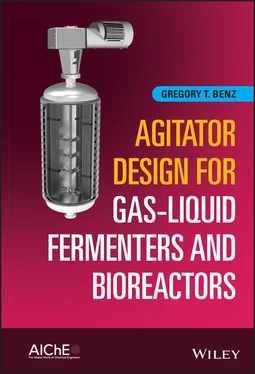1 ...7 8 9 11 12 13 ...16 (3.5) 
It is used to calculate the flow created by the impeller, which can be used to determine a characteristic velocity in the tank. It is a function of impeller type, Reynolds number, and geometric parameters.
The units used for N and D determine the resultant units for Q. For example, if D is in feet, and N is in rpm, Q will be expressed as cubic feet per minute. Likewise, if D is in m and N is in revolutions per second, Q will be in cubic meters per second.
There are many different ways to measure impeller pumping, and they do not all give the same results. The most widely accepted methods define a discharge area around the impeller and measure flow through it, usually by use of either laser Doppler or particle image velocimeters. It is not within the scope of this book to discuss such methods. The above methods measure what is commonly called primary impeller flow or discharge. There can also be entrained flow, which can be several times as high as the primary flow. Any claimed impeller pumping capacity should state whether it is primary flow or total flow.
Dimensionless blend time is the product of blend time (defined as the time to reach some degree of concentration variance reduction after an assigned starting time) times the shaft speed. In other words:
(3.6) 
This group is used to determine the blend time to some degree of attenuation of concentration differences. It is the product of blend time and shaft speed. Essentially, it is how many revolutions of the impeller are required to achieve a certain degree of blending. It is a function of Reynolds number, impeller type, and geometric factors. Rarely is blend time a limiting factor in fermenters.
Sometimes, people will add a factor of (D/T) αto the right‐hand side of the equation to correct for geometric effects. The value of α depends on the impeller type, but is usually about 2.3 for pitched blade and straight blade turbines, and about 1.73 for propellers and hydrofoils.
Aeration number, also called gas flow number, is the ratio of actual gas flow rate at the impeller (corrected for absolute pressure and temperature) divided by the impeller diameter cubed and the shaft speed:
(3.7) 
This group is used for power draw calculations in the gassed condition, along with other dimensionless groups. It can be thought of, in a way, as being proportional to the ratio of gas flow rate to the impeller pumping capacity.
When gas is introduced into an impeller or is present in the tank, it affects the impeller power draw. Usually, it reduces the power draw, but under some circumstances, it may increase it. The ratio of gassed power to ungassed power is called the gassing factor, and it does not usually have a special symbol for it. Instead, the ratio is simply expressed as a ratio: P g/P u.
It is a function of impeller type, Reynolds number, Aeration number, Froude number, and geometric factors.
The Nusselt number is the ratio of the convective heat transfer coefficient times a reference length divided by the thermal conductivity of the fluid. The reference length dimension depends on the heat exchange surface. For a vessel jacket, that will normally be the tank diameter. For tubes inside the tank, it would normally be the tube OD. Expressed in terms of tank diameter, we have:
(3.8) 
It is used in heat transfer calculations, to determine the convective coefficient, h. It is a function of impeller type, Reynolds number, Prandtl number, and various geometric factors, as well as the ratio of local viscosity to bulk viscosity.
Froude number is the ratio of a reference rotational speed times a reference velocity divided by the local gravitational acceleration. For similar reasons that we used for Reynolds number, we use N for rotational speed and ND for velocity, resulting in:
(3.9) 
Note that g is not a constant; it is the local gravitational acceleration. While it is almost uniform on the Earth’s surface, it will be quite different on other planets. So the same impeller operating at the same speed would have different Froude numbers on Earth, the moon, Mars, and Jupiter. This will be important if we ever build fermenters on another planet.
Conceptually, the Froude number is the ratio of inertial forces to gravitational forces. High Froude numbers mean inertia dominates. This is associated with a choppy surface and vortex formation. Low Froude numbers mean gravity dominates, which is associated with a quiet, flat surface. Froude number, in combination with Reynolds number, impeller type, baffle number, and various geometric factors, can be used to predict mean vortex depth.
In gas–liquid contacting, the impeller gassing factor is a function of Froude number, impeller type, Reynolds number, Aeration number, and geometry factors. That is its principal use for bioreactor design. It is also used in most impeller flooding correlations.
Prandtl number is simply a physical property group used in heat transfer correlations:
(3.10) 
The Nusselt number is a function of the Prandtl number. Care must be taken to make sure all units cancel. The most common units for the fluid properties, especially viscosity, do not cancel. SI units work well. If common English units are used, the viscosity must be converted to pounds mass/foot‐hour. The conversion is 1 cP = 2.419 lb/ft‐h.
Relative size and placement of impellers in a tank affects power draw, blend time, pumping capacity, solids suspension capability, vortex formation and maybe a few other things. Some parameters are more sensitive to geometry than others. The dimensionless geometric ratios used in calculations include D/T, Z/T, C/T, S/D, O/T, and W/D. As long as the same units are used for numerator and denominator, it does not matter what system of units is used.
Although this could be lumped in under geometric ratios, it affects things in different and important ways, so I decided to mention it separately. Essentially, it represents total baffle width (calculated normal to the tank wall) divided by tank diameter:
(3.11) 
Power draw and vortex formation depend on baffle number. At a baffle number of zero, the tank is called unbaffled and power draw is at a minimum. Under such a condition, in turbulent flow, there is a lot of swirl, with mostly tangential motion rather than axial or radial. Gas dispersion is essentially impossible to do under such a condition. As baffle number increases, power draw increases to a maximum and then falls off. In the USA, “standard” baffling is 4 baffles at 90° to the tank wall, each one being 1/12 of the tank diameter, resulting in a baffle number of 0.33. In Europe, it is more common to use a baffle width of 1/10 of the tank diameter, giving a baffle number of 0.4. The power draw is pretty constant over this range and is basically at the maximum. D/T and impeller type also interact with baffle number.
Читать дальше



















